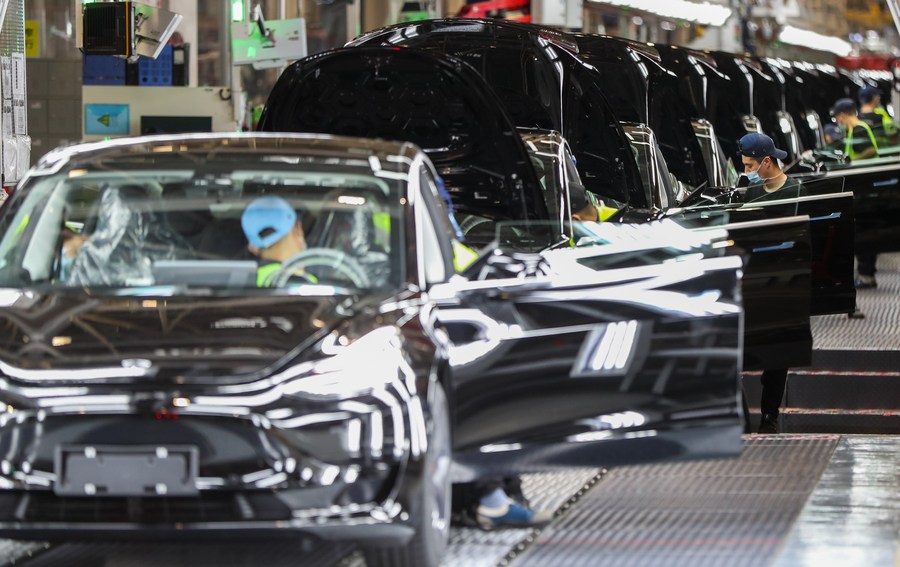

China has managed to overcome challenges and maintain its appeal to foreign investors in 2020. According to official statistics, foreign direct investment (FDI) into the Chinese mainland, in actual use, expanded 6.2 percent year-on-year to a record high of 999.98 billion yuan in 2020.
The country’s auto market saw a V-shared turn along with a bounce in investment and export over the last year, said Stephan Wöllenstein, CEO of Volkswagen Group China. In 2020, the company delivered 3.85 million vehicles in China, representing a market share of 19.3 percent, he introduced.

Employees work at the Tesla Gigafactory in Shanghai, east China, Nov. 20, 2020. (Xinhua/Ding Ting)
Merck Holding (China) Co., Ltd, was among the first batch of enterprises to resume production in Shanghai. Last July, it opened a life science innovation highland in the city’s Zhangjiang and registered steady growth in the life science, medicine and healthcare, and high-performance materials.
The Chinese economy has moved forward with strong resilience despite uncertainties faced by the global economy, said Li Ye, vice president of Merck Holding (China) Co. Ltd, adding that by quickly controlling the epidemic and issuing a basket of policy measures to help enterprises, China has stabilized foreign enterprises’ confidence.
Last year, China’s FDI got back on its feet with a year-on-year growth in April, and maintained an upward momentum till year-end.
A recent survey by the Ministry of Commerce showed that profits of nearly 60 percent of foreign-invested firms in 2020 posted growth or remained flat compared with a year ago, with nearly 95 percent holding an optimistic attitude about future prospects.
“In 2020, we invested 5.4 billion dollars in China, 83 percent of which went to middle and western China, mostly in the high-tech industry,” said Deuk-kyu Hwang, president of Samsung China.
Thanks to a “green passage” built by the Chinese government, last year, Samsung China dispatched 24 charter airplanes to transport 5,500 foreign engineers to China to restart their work, guaranteeing the opening of new projects and construction of major projects, Hwang disclosed.
China’s opening-up momentum has remained unabated. The country rolled out measures including cutting its negative list for foreign investors, building three pilot free trade zones, signing the Regional Comprehensive Economic Partnership (RCEP), and completing investment agreement negotiations with the European Union as scheduled.
The country has constantly improved the business environment. A survey jointly conducted by the Ministry of Commerce and www.gov.cn showed that nearly 90 percent of the enterprises think the foreign investment law has been well implemented.
Last year, the Ministry of Commerce set up a task force to serve 697 key foreign-funded projects, solving more than 3,000 issues concerning the resumption of work and production and helping about 16,000 foreign employees to return to China.
“At present, our 43 multinational pharmaceutical company members have built 47 factories and 25 R&D centers in China, with investment reaching 12.2 billion yuan in 2020,” said Kang Wei, managing director for the R&D-based Pharmaceutical Association Committee (RDPAC) under the China Association of Enterprises with Foreign Investment.
As an important link connecting the domestic and international markets, foreign-funded enterprises contribute 10 percent of China’s urban employment, 16.6 percent of the tax revenue, and 40 percent of the country’s imports and exports, and they will surely become an important new force for the country to build a new development pattern in the future.
 Fire brigade in Shanghai holds group wedding
Fire brigade in Shanghai holds group wedding Tourists enjoy ice sculptures in Datan Town, north China
Tourists enjoy ice sculptures in Datan Town, north China Sunset scenery of Dayan Pagoda in Xi'an
Sunset scenery of Dayan Pagoda in Xi'an Tourists have fun at scenic spot in Nanlong Town, NW China
Tourists have fun at scenic spot in Nanlong Town, NW China Harbin attracts tourists by making best use of ice in winter
Harbin attracts tourists by making best use of ice in winter In pics: FIS Alpine Ski Women's World Cup Slalom
In pics: FIS Alpine Ski Women's World Cup Slalom Black-necked cranes rest at reservoir in Lhunzhub County, Lhasa
Black-necked cranes rest at reservoir in Lhunzhub County, Lhasa China's FAST telescope will be available to foreign scientists in April
China's FAST telescope will be available to foreign scientists in April "She power" plays indispensable role in poverty alleviation
"She power" plays indispensable role in poverty alleviation Top 10 world news events of People's Daily in 2020
Top 10 world news events of People's Daily in 2020 Top 10 China news events of People's Daily in 2020
Top 10 China news events of People's Daily in 2020 Top 10 media buzzwords of 2020
Top 10 media buzzwords of 2020 Year-ender:10 major tourism stories of 2020
Year-ender:10 major tourism stories of 2020 No interference in Venezuelan issues
No interference in Venezuelan issues
 Biz prepares for trade spat
Biz prepares for trade spat
 Broadcasting Continent
Broadcasting Continent Australia wins Chinese CEOs as US loses
Australia wins Chinese CEOs as US loses